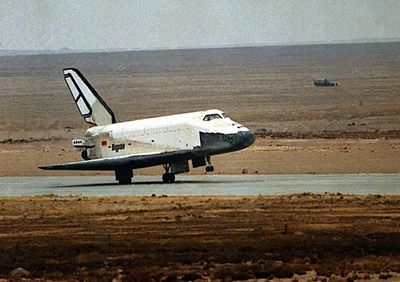Theft, the sincerest form of flatteryby Dwayne A. Day
|
| But unlike many of their acquisitions of American military technology, the shuttle information was apparently acquired from commercial databases. |
The Soviet shuttle, though, was not a copy of the American shuttle. Its outer mold line (i.e. the shape of the fuselage) was similar. But there were significant differences, such as the fact that the Soviet shuttle did not carry heavy rocket engines in its tail, thereby completely changing its flying characteristics. However, the Soviet shuttle did benefit substantially from American space shuttle technology—at least that’s what the CIA had concluded in a recently declassified report on Soviet thefts of western technology.
The 1985 report, titled “Soviet Acquisition of Militarily Significant Western Technology: An Update,” began with a somewhat ominous preface:
In recent years, the United States Government has learned of a massive, well-organized campaign by the Soviet Union to acquire Western technology illegally and legally for its weapons and military equipment projects. Each year Moscow receives thousands of pieces of Western equipment and many tens of thousands of unclassified, classified, and proprietary documents as part of this campaign. Virtually every Soviet military research project—well over 4,000 each year in the late 1970s and over 5,000 in the early 1980s—benefits from these technical documents and hardware. The assimilation of Western technology is so broad that the United States and other Western nations are thus subsidizing the Soviet military buildup.
The report detailed numerous examples of what technology was acquired, what Soviet intelligence service acquired it, and how it was applied. “Documents on systems and heat shielding of the US space shuttle” were acquired by the KGB and used in the Soviet Union’s own space shuttle program, according to the report.
But unlike many of their acquisitions of American military technology (for example, information on the fire control system for the brand new F/A-18 Hornet fighter), the shuttle information was apparently acquired from commercial databases. The report stated:
…from the mid-1970s to the early 1980s, NASA documents and NASA-funded contractor studies provided the Soviets with their most important source of unclassified material in the aerospace area. Soviet interests in NASA activities focused on virtually all aspects of the space shuttle. Documents acquired dealt with airframe designs (including computer programs on design analysis), materials, flight computer systems, and propulsion systems. This information allowed Soviet military industries to save years of scientific research and testing time as well as millions of rubles as they developed their own very similar space shuttle vehicle.
The report noted that “Requirements for documents alone can command amounts as considerable as hardware; examples include over 50,000 rubles (roughly $140,000 in 1980 purchase power equivalents) for documents on the U.S. shuttle orbiter control system…”
The way that the CIA learned of this massive Soviet technology acquisition effort—and what they did about it—demonstrates that the United States government did not simply allow itself to be the unknowing victim of an espionage campaign.
| The CIA had already developed a rather diabolical response to the technology theft effort. If the Soviet Union had an insatiable appetite for Western technology, the CIA would feed it some poison. |
In the early 1980s, Colonel Vladimir Vetrov of the KGB began supplying thousands of secret documents to the French intelligence service. Vetrov’s job involved evaluating stolen Western technology, and he apparently exposed the collection effort to the French, earning himself the codename “Farewell.” The French president shared the information with President Ronald Reagan, and turned over the material, known as “the Farewell Dossier.” In 1982, in a rather bizarre and murky incident, Vetrov apparently got into an argument with a fellow KGB officer and a woman and stabbed them both, killing the man. He was arrested and during interrogation revealed that he had been spying for the French. He was executed in 1983.
But the CIA had already developed a rather diabolical response to the technology theft effort. If the Soviet Union had an insatiable appetite for Western technology, the CIA would feed it some poison. According to Reagan official Thomas Reed, the CIA fabricated fake integrated circuits for use in the computer system for a gas pipeline and made sure that they found their way into a Siberian pipeline project. In 1982 that pipeline suffered a massive explosion, allegedly because of the CIA computer sabotage. Although the story seems far-fetched, it is also eerily reminiscent of the Stuxnet computer virus introduced into Iranian uranium centrifuge computer systems over two decades later.
The CIA was able to use Vetrov’s information to roll up the worldwide Soviet technology collection network, stemming the flow of secrets and unclassified data through the KGB and GRU (Soviet military intelligence). By the mid-1980s the Soviets were reportedly starved for American technology secrets. Even without this counter-intelligence operation, the CIA estimated in several reports that the Soviet Union would soon find it nearly impossible to reverse-engineer Western integrated circuits, which were getting too complicated to copy.
Perhaps the greatest irony about the theft of American space shuttle technology is that it probably worked in the United States’ favor. The Soviet space shuttle was a white elephant, too expensive for the Soviet Union to operate and with no effective mission. The Soviets might have saved money in its development, but that only ensured that they would be stuck with something too expensive to afford.
